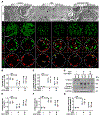Melanocortin therapy ameliorates podocytopathy and proteinuria in experimental focal segmental glomerulosclerosis involving a podocyte specific non-MC1R-mediated melanocortinergic signaling
- PMID: 32167144
- PMCID: PMC9870294
- DOI: 10.1042/CS20200016
Melanocortin therapy ameliorates podocytopathy and proteinuria in experimental focal segmental glomerulosclerosis involving a podocyte specific non-MC1R-mediated melanocortinergic signaling
Abstract
The clinical effectiveness of adrenocorticotropin in inducing remission of steroid-resistant nephrotic syndrome points to a steroidogenic-independent anti-proteinuric activity of melanocortins. However, which melanocortin receptors (MCR) convey this beneficial effect and if systemic or podocyte-specific mechanisms are involved remain uncertain. In vivo, wild-type (WT) mice developed heavy proteinuria and kidney dysfunction following Adriamycin insult, concomitant with focal segmental glomerulosclerosis (FSGS) and podocytopathy, marked by loss of podocin and synaptopodin, podocytopenia and extensive foot process effacement on electron microscopy. All these pathologic findings were prominently attenuated by NDP-MSH, a potent non-steroidogenic pan-MCR agonist. Surprisingly, MC1R deficiency in MC1R-null mice barely affected the severity of Adriamycin-elicited injury. Moreover, the beneficial effect of NDP-MSH was completely preserved in MC1R-null mice, suggesting that MC1R is likely non-essential for the protective action. A direct podocyte effect seems to contribute to the beneficial effect of NDP-MSH, because Adriamycin-inflicted cytopathic signs in primary podocytes prepared from WT mice were all mitigated by NDP-MSH, including apoptosis, loss of podocyte markers, de novo expression of the podocyte injury marker desmin, actin cytoskeleton derangement and podocyte hypermotility. Consistent with in vivo findings, the podoprotective activity of NDP-MSH was fully preserved in MC1R-null podocytes. Mechanistically, MC1R expression was predominantly distributed to glomerular endothelial cells in glomeruli but negligibly noted in podocytes in vivo and in vitro, suggesting that MC1R signaling is unlikely involved in direct podocyte protection. Ergo, melanocortin therapy protects against podocyte injury and ameliorates proteinuria and glomerulopathy in experimental FSGS, at least in part, via a podocyte-specific non-MC1R-mediated melanocortinergic signaling.
Keywords: adrenocorticotropic hormone; apoptosis; cytoskeleton; glomerular disease; podocytes.
© 2020 The Author(s). Published by Portland Press Limited on behalf of the Biochemical Society.
Figures






Similar articles
-
MC1R is dispensable for the proteinuria reducing and glomerular protective effect of melanocortin therapy.Sci Rep. 2016 Jun 8;6:27589. doi: 10.1038/srep27589. Sci Rep. 2016. PMID: 27270328 Free PMC article.
-
Melanocortin 5 receptor signaling protects against podocyte injury in proteinuric glomerulopathies.Kidney Int. 2025 May;107(5):835-851. doi: 10.1016/j.kint.2025.01.009. Epub 2025 Jan 23. Kidney Int. 2025. PMID: 39862971
-
Bradykinin receptor 1 activation exacerbates experimental focal and segmental glomerulosclerosis.Kidney Int. 2011 Jun;79(11):1217-27. doi: 10.1038/ki.2011.14. Epub 2011 Mar 16. Kidney Int. 2011. PMID: 21412216
-
Leveraging melanocortin pathways to treat glomerular diseases.Adv Chronic Kidney Dis. 2014 Mar;21(2):134-51. doi: 10.1053/j.ackd.2013.09.004. Adv Chronic Kidney Dis. 2014. PMID: 24602463 Free PMC article. Review.
-
Pathobiology of focal segmental glomerulosclerosis: new developments.Curr Opin Nephrol Hypertens. 2012 May;21(3):243-50. doi: 10.1097/MNH.0b013e32835200df. Curr Opin Nephrol Hypertens. 2012. PMID: 22357339 Review.
Cited by
-
Post-transplant glomerular diseases: update on pathophysiology, risk factors and management strategies.Clin Kidney J. 2024 Oct 24;17(12):sfae320. doi: 10.1093/ckj/sfae320. eCollection 2024 Dec. Clin Kidney J. 2024. PMID: 39664990 Free PMC article. Review.
-
Therapeutic trials in adult FSGS: lessons learned and the road forward.Nat Rev Nephrol. 2021 Sep;17(9):619-630. doi: 10.1038/s41581-021-00427-1. Epub 2021 May 20. Nat Rev Nephrol. 2021. PMID: 34017116 Free PMC article. Review.
-
Visualized podocyte-targeting and focused ultrasound responsive glucocorticoid nano-delivery system against immune-associated nephropathy without glucocorticoid side effect.Theranostics. 2021 Jan 1;11(6):2670-2690. doi: 10.7150/thno.53083. eCollection 2021. Theranostics. 2021. PMID: 33456566 Free PMC article.
-
Mechanisms of Scarring in Focal Segmental Glomerulosclerosis.Kidney Dis (Basel). 2021 Sep;7(5):350-358. doi: 10.1159/000517108. Epub 2021 Jul 2. Kidney Dis (Basel). 2021. PMID: 34604342 Free PMC article. Review.
-
Melanocortin System in Kidney Homeostasis and Disease: Novel Therapeutic Opportunities.Front Physiol. 2021 Feb 24;12:651236. doi: 10.3389/fphys.2021.651236. eCollection 2021. Front Physiol. 2021. PMID: 33716796 Free PMC article. Review.
References
-
- D’Agati VD, Kaskel FJ and Falk RJ (2011) Focal segmental glomerulosclerosis. The New England journal of medicine. 365, 2398–2411 - PubMed
Publication types
MeSH terms
Substances
Grants and funding
LinkOut - more resources
Full Text Sources

